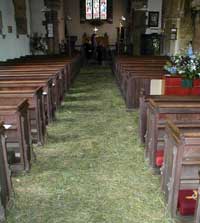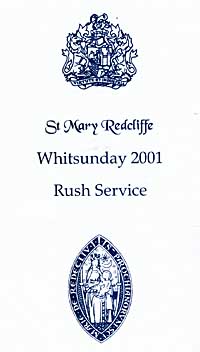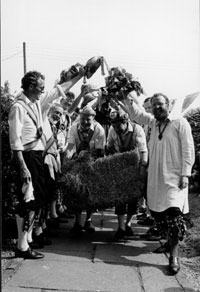 |
 |
 |
 |
 |
|
|
 |
A National Tradition An 1870 account of the rush strewing in Saddleworth gives an indication of what could have taken place in
Wingrave, if villagers had not been so vigilant. "The last time rushes were spread in the church was in 1821; they were often spread to a depth of twelve to fifteen inches. After the rushes ceased to be used on the church floor, they were used as bedding for cattle. Some few years ago the landlord of the "Church Inn" used to give a sovereign a load for them, but of late years no cart has been taken up to the church."
Grass in the church at Shenington Oxfordshire. One of the most ancient traditions is at St Mary Redcliffe in Bristol, where since 1494 at Pentecost (June 3) the floor of the Church is strewn with rushes and a service is held to which all the civic dignitaries of the City are invited.
Programme for service of St Mary Redcliffe, Bristol. The rush bearing ceremonies of Lancashire and Cumbria are interesting. Rushes were cut, dried, and then carried in carts to the churchyard. The rushes were then strewn along the aisles of the church and in the bottoms of the pews, in preparation for winter. A description of a rush strewing ceremony in about 1780 shows what may have happened in Wingrave "the rushes were "teemed" down near the chapel gates. The old ones of last year having been cleared out of the chapel, the new ones were carried in, and carefully strewn in the bottom of the pews, aisles, etc. On this day, also, the band, accompanied by the pikemen carrying staves surmounted with brass eagles, perambulated the village, stopping nowhere, neither soliciting nor receiving any contributions"
The Morris Men enter Wingrave Church (1986) A song used in Bishops Castle, Shropshire during rush bearing gives a flavour of the integration of the celebrations of the Village Feast day, rush strewing and the church festival.
Good Day to you, you merry men all |
| home | village map | about us | contact |


